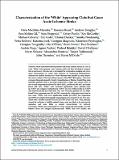Characterization of the ‘White’ appearing clots that cause acute ischemic stroke

View/
Date
2021-09-28Author
Mereuta, Oana Madalina
Rossi, Rosanna
Douglas, Andrew
Molina Gil, Sara
Fitzgerald, Seán
Pandit, Abhay
McCarthy, Ray
Gilvarry, Michael
Ceder, Eric
Dunker, Dennis
Nordanstig, Annika
Redfors, Petra
Jood, Katarina
Magoufis, Georgios
Psychogios, Klearchos
Tsivgoulis, Georgios
O'Hare, Alan
Power, Sarah
Brennan, Paul
Nagy, András
Vadász, Ágnes
Brinjikji, Waleed
Kallmes, David F.
Szikora, Istvan
Rentzos, Alexandros
Tatlisumak, Turgut
Thornton, John
Doyle, Karen M.
Metadata
Show full item recordUsage
This item's downloads: 569 (view details)
Cited 0 times in Scopus (view citations)
Recommended Citation
Mereuta, Oana Madalina, Rossi, Rosanna, Douglas, Andrew, Gil, Sara Molina, Fitzgerald, Seán, Pandit, Abhay, . . . Doyle, Karen M. (2021). Characterization of the ‘White’ Appearing Clots that Cause Acute Ischemic Stroke. Journal of Stroke and Cerebrovascular Diseases, 30(12), 106127. doi:https://doi.org/10.1016/j.jstrokecerebrovasdis.2021.106127
Published Version
Abstract
Objectives
Most clots retrieved from patients with acute ischemic stroke are ‘red’ in color. ‘White’ clots represent a less common entity and their histological composition is less known. Our aim was to investigate the composition, imaging and procedural characteristics of ‘white’ clots retrieved by mechanical thrombectomy.
Materials and methods
Seventy five ‘white’ thrombi were selected by visual inspection from a cohort of 760 clots collected as part of the RESTORE registry. Clots were evaluated histopathologically.
Results
Quantification of Martius Scarlett Blue stain identified platelets/other as the major component in ‘white’ clots’ (mean of 55% of clot overall composition) followed by fibrin (31%), red blood cells (6%) and white blood cells (3%). ‘White’ clots contained significantly more platelets/other (p<0.001*) and collagen/calcification (p<0.001*) and less red blood cells (p<0.001*) and white blood cells (p=0.018*) than ‘red’ clots. The mean platelet and von Willebrand Factor expression was 43% and 24%, respectively. Adipocytes were found in four cases. ‘White’ clots were significantly smaller (p=0.016*), less hyperdense (p=0.005*) on computed tomography angiography/non-contrast CT and were associated with a smaller extracted clot area (p<0.001*) than ‘red’ clots. They primarily caused the occlusion of middle cerebral artery, were less likely to be removed by aspiration and more likely to require rescue-therapy for retrieval.
Conclusions
‘White’ clots represented 14% of our cohort and were platelet, von Willebrand Factor and collagen/calcification-rich. ‘White’ clots were smaller, less hyperdense, were associated with significantly more distal occlusions and were less successfully removed by aspiration alone than ‘red’ clots.

